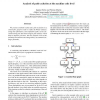102
click to vote
WCET
2007
15 years 1 months ago
2007
Body area network (BAN) applications have stringent timing requirements. The timing behavior of a BAN application is determined not only by the software complexity, inputs, and ar...
75
Voted
WCET
2007
15 years 1 months ago
2007
71
Voted
WCET
2007
15 years 1 months ago
2007
Tracing the flow of control in code generated from switchcase statements is difficult for static program analysis tools when the code contains �...
105
click to vote
WCET
2007
15 years 1 months ago
2007
Memory corruption is one of the most common software failures. For sequential software and multitasking software with synchronized data accesses, it has been shown that program fa...
WCET
2007
15 years 1 months ago
2007
We present a method to find static path exclusions in a control flow graph in order to refine the WCET analysis. Using this information, some infeasible paths can be discarded ...
103
Voted
WCET
2007
15 years 1 months ago
2007
Worst-case execution time (WCET) analysis is indispensable for the successful design and development of systems, which, in addition to their functional constraints, have to satisf...
113
Voted
WCET
2007
15 years 1 months ago
2007
Our research focuses on formally bounded WCET analysis, where we aim to provide absolute guarantees on execution time bounds. In this paper, we describe how amortisation can be us...
90
Voted
WCET
2007
15 years 1 months ago
2007
For component-based systems, classical techniques for Worst-Case Execution Time (WCET) estimation produce unacceptable overestimations of a components WCET. This is because softwa...
103
Voted
WCET
2007
15 years 1 months ago
2007
To calculate the WCET of a program, safe upper bounds on the number of loop iterations for all loops in the program are needed. As the manual annotation of all loops with such bou...
WCET
2003
15 years 2 months ago
2003
Calculating the WCET of mission-critical satellite applications is a challenging issue. The European Space Agency is currently undertaking the CryoSat mission, consisting of a rad...




